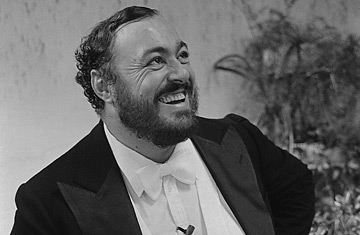
Luciano Pavarotti before a recital.
Audience members at the Metropolitan Opera looked at one another in amazement. Did we just hear what we thought we heard? Onstage, the strapping young Italian tenor singing opposite Joan Sutherland in The Daughter of the Regiment had just trumpeted a ringing high C, then another, and another. He was singing an aria that most tenors transpose down a step, in order to get by on B-flats (tough enough). But this fellow tossed off every high C in the aria with astonishing ease and brilliance — nine in all. The effect was electrifying. Within a day the Met box office was besieged, and Manhattan's media mills swung into action.
That was in 1972. The tenor was Luciano Pavarotti. For a decade he had been building an international operatic reputation as a real comer. Now, with those high C's at the Met, he announced that he had fully arrived. Virtually from that moment until he died this week of pancreatic cancer at 71, he reigned in the public mind as the primo tenor — make that the primissimo tenor — of his day.
The extravagance of the label was just right. In both his music and his personality, Pavarotti's exuberance was multissimo. His voice — "one of those freaks of nature that comes very rarely in a hundred years," according to conductor Richard Bonynge — had a clear, penetrating timbre, alive with the resonance known to singers as "ping." At the same time it radiated a gorgeously warm romantic sheen. He produced it with an unforced, open-throated quality that Italians call lasciarsi andare — letting it pour forth.
He also poured forth showmanship. A six-footer who weighed 300 pounds or more for much of his life, he had a Rabelaisian appetite for food and fun. Offstage he clowned on TV talk shows, appeared in commercials and movies, and generated nonstop tabloid copy. Reports of his dietary struggles and weight fluctuations circulated like a runaway Dow Jones average: up 25, down 80, up 60. He was a household name to millions of people who had never seen the inside of an opera house.
Onstage he connected viscerally with audiences. Taking his bows, he spread wide his enormous stevedore arms in a gesture of embrace, often flaunting a trademark white handkerchief that was approximately the size of Rhode Island. As applause cascaded over him, he visibly inhaled it like life-giving oxygen, which it was to him. "I am enthusiastic of the job I do and enthusiastic of life," he once said. "The pleasure of the profession is the human warmth around me, the public out there."
In the 1980s and '90s the showmanship tended to take over. At a time when Pavarotti was canceling more and more performances at the world's opera houses, he turned to solo concerts in such big venues as sports arenas, convention centers, even a circus tent. He issued a slew of commercial recordings, racking up sales that gave pop stars like Elton John a run for their money. He barnstormed with Placido Domingo and Jose Carreras as "The Three Tenors," favoring spectacular settings like the Baths of Caracalla in Rome, which in turn yielded still more recordings and TV specials. "I want to be famous everywhere," he said, and he was.
It was heady stuff for a baker's son from the small Italian city of Modena, who had briefly taught elementary school and sold insurance while pursuing his vocal studies. As late as the 1970s Pavarotti liked to say he was still "a country boy," and he played up his modest roots by spending his summers on home turf, swimming, riding horses and expertly whipping up pasta feasts. But his family home was now a 17th century mansion on 12 acres, and there was no disguising his status as an immensely wealthy international superstar. Eventually his prolonged globetrotting absences took a toll on family life. In 1996 he separated from the Modena girl he had married 35 years before, Adua Veroni, to be with his secretary, Nicoletta Mantovani, whom he married in 2003.
Pavarotti was unquestionably the most celebrated and most exciting tenor in the second half of the 20th century. Was he also the best? Here a definition of terms is in order. Some tenors ranged more widely through the repertory. Pavarotti concentrated on the classic lyric roles in such works as La Boheme, La Traviata and Madame Butterfly, and in later decades, when his voice turned darker, added more forceful roles like those in Tosca and Un Ballo in Maschera; but he rarely ventured into ruggedly dramatic territory, and almost never sang in any language but Italian.
Still other tenors displayed more refinement and style, and brought a richer cultural or intellectual background to their roles. A case in point: Domingo, the other dominant tenor of the era, a more consistent, versatile and rounded singer than Pavarotti and a far more affecting actor (a domain where Pavarotti's skills remained, to put it kindly, rudimentary).
Yet no one matched Pavarotti at his best for sheer, prodigal outpouring of vocal beauty. And what he lacked in subtlety and polish he made up for in vitality, natural talent and entertainment value. In this sense Pavarotti the celebrity and Pavarotti the artist were one. The same simplicity, verve and generosity of spirit that made him a walking media event shone through his resplendent voice. His singing expressed the identical quality that it inspired in listeners around the world: an instinctive joy in the performance itself.
